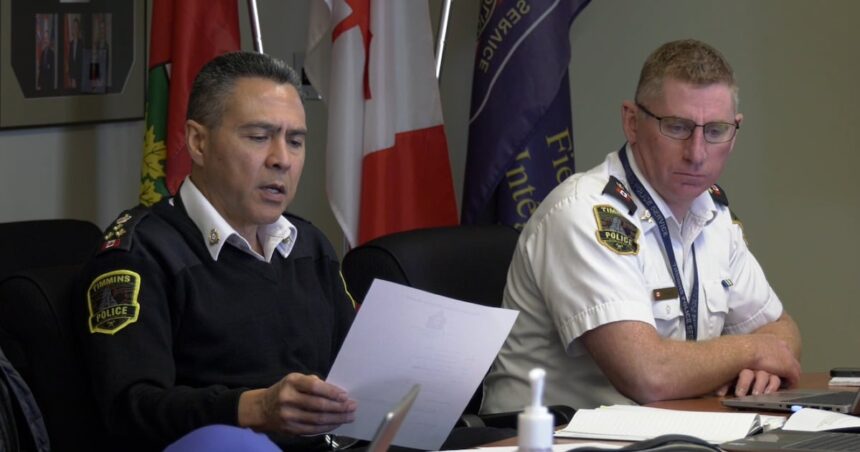The scene at Timmins Police Service headquarters has changed noticeably in recent months. Beyond the usual bustle of officers in uniform, civilian specialists now occupy key positions in what Chief Dan Foy calls “a necessary evolution” of policing in Northern Ontario.
“We’ve recognized that traditional policing models simply aren’t equipped to handle today’s challenges,” Foy told me during a tour of their renovated operations center. “Our communities expect more sophisticated responses to complex issues, and that requires specialized knowledge we didn’t traditionally develop in-house.”
The modernization push involves hiring mental health coordinators, data analysts, and community engagement specialists – positions that didn’t exist on the force just five years ago. This transformation reflects a broader shift happening across Canadian law enforcement, though with distinct northern challenges.
According to Timmins Police Service data, mental health-related calls increased 37% between 2020 and 2023. Rather than training officers to become mental health experts, the service has partnered with local health authorities to embed trained crisis workers who can respond alongside officers.
Melissa Tremblay, newly hired as the service’s first Mental Health Response Coordinator, describes her role as “bridging worlds that should have been working together all along.”
“Officers were doing their best, but they’re not clinicians,” Tremblay explained. “We’re seeing better outcomes when people in crisis meet a specialist first, with police providing security rather than leading interventions.”
The hiring initiative hasn’t come without criticism. At recent town council meetings, questions about budget priorities emerged, with some residents questioning whether new administrative positions address core concerns about response times in outlying areas.
City Councillor Mark Wilson defended the investments at April’s budget hearing. “When we look at calls consuming most officer time, many don’t require traditional policing skills. Having specialists handle those calls actually improves response where armed officers are truly needed.”
Financial realities have shaped implementation. Unlike larger southern services, Timmins operates with tighter resource constraints. Their modernization budget of $1.2 million over three years represents significant investment for a service of their size, though it’s modest compared to similar initiatives in larger centers.
Statistics Canada reported that northern communities face unique policing challenges – covering vast geographic areas with fewer resources while addressing increasingly complex social issues. Their 2023 report on policing trends noted that specialized hiring has increased 18% nationally in medium-sized police services.
The most innovative addition might be the new Digital Evidence Specialist position. In an age where nearly every incident involves some digital component, officers were spending hours managing video evidence that specialized technicians can process more efficiently.
“Ten years ago, a single case might have involved reviewing one security camera,” explained Technical Services Manager Karen Louttit. “Today, we’re collecting doorbell footage, social media posts, and dozens of witness videos for even routine incidents. Having dedicated specialists means officers can return to community work faster.”
Community reaction has been mixed but trending positive. At a recent public forum I attended at Northern College, residents expressed appreciation for more nuanced approaches to community problems, particularly around youth engagement and addiction issues.
Elder Joseph Nakogee from Attawapiskat First Nation, who serves on the police community advisory board, sees potential in the new direction. “What matters is whether these new roles help police understand our communities better. If specialists build bridges rather than just manage problems, that’s progress.”
Chief Foy acknowledges the transition hasn’t been perfectly smooth. Some veteran officers initially questioned whether specialized civilian roles might diminish traditional policing authority. He points to improving metrics around case clearance and officer availability as evidence the approach is working.
“What we’re finding is that officers actually feel more effective when they can focus on what they’re trained to do,” Foy said. “Nobody signed up to be an expert in everything, and having specialists to handle complex aspects of cases improves morale.”
The service has also invested in training exchanges with southern Ontario services. Last month, four Timmins officers completed observation rotations with Peel Regional Police’s specialized units to bring best practices back north.
Ontario Police College instructor Samuel Okeke, who consulted on the Timmins transformation, sees their approach as potentially influential for similarly-sized services. “What’s interesting about Timmins is they’re not simply copying big-city models. They’re creating hybrid roles that make sense for northern realities.”
The hiring initiative continues through 2024, with three specialist positions still to be filled. Chief Foy emphasized that modernization extends beyond new positions to include updated training for existing officers and improved technology infrastructure.
For residents like Marguerite Koistinen, who I spoke with outside the police station, practical results matter most. “I just want to know that when my neighborhood has problems, someone with the right skills will help solve them,” she said. “If that means different kinds of people working at the police service, that makes sense to me.”
As Canadian policing continues evolving, the Timmins experiment offers an intriguing case study in how medium-sized services can modernize despite resource limitations. Whether their model becomes a template for other northern communities depends on results that will take several years to fully assess.






